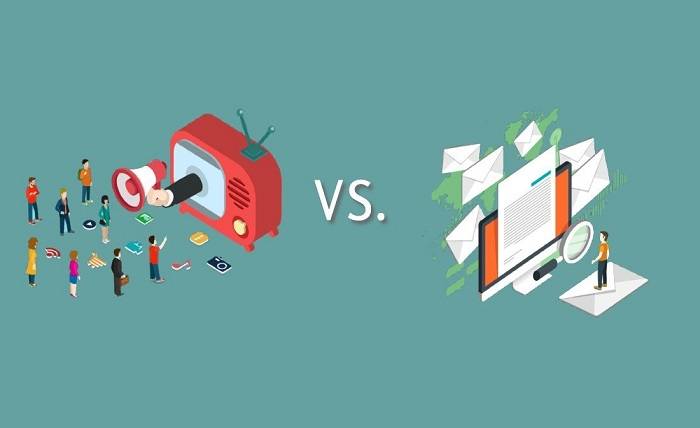
What distinguishes traditional marketing from digital marketing, and which should you choose? You are in the proper place if you are thinking of all these questions. We will address all of your inquiries. In the age of digitization, marketing plays a crucial role in brand promotion and brand exposure, therefore picking the right marketing strategy is crucial.
Why would any marketer continue to spend money on conventional strategies when social media and digital marketing have so many advantages for increasing brand awareness?
We will first examine the various advantages and disadvantages of traditional marketing and digital marketing in this post. You will learn some astounding things about these two.
Before I discuss digital marketing vs. traditional marketing, you might be asking how to learn about marketing and its tactics. You can learn top digital marketing skills by doing a Post Graduation in Digital Marketing.
Digital marketing is marketing carried out for an online audience using digital platforms and methods in order to achieve marketing goals and connect with potential clients. It employs digital marketing websites and platforms, such as social media, paid advertising, and many more, to advertise goods and services.
Traditional marketing is carried out through tangible tools rather than digital ones, such as radio, television, newspapers, magazines, and billboards. It mostly engages audiences offline through promotion. In general, any offline marketing falls under the category of traditional marketing’s perimeter. Let’s now compare traditional marketing to digital marketing.
Bonus Read: Digital Marketing Course in Mumbai
What Differs Digital Marketing from Traditional Marketing?
Traditional and digital marketing differ in the following ways:
| Traditional Marketing | Digital Marketing |
| Traditional marketing primarily focuses on employing traditional techniques to promote a brand, service, or campaign, such as radio, television, newspapers, magazines, and hoardings. | Digital marketing is focused on leveraging websites and online marketing channels to advertise and sell a company’s goods and services. |
| In traditional marketing, you must concentrate on the offline media platforms that the target audience utilises to receive content. | In digital marketing, you must concentrate on the audience that uses digital platforms to interact online. |
| When compared to digital marketing, selling a product is laborious and moment. | Compared to traditional marketing, selling a product is incredibly simple. |
| You may connect with a local audience in your area through traditional marketing. | You may quickly connect with a larger, more varied audience from around the globe. |
| Customers cannot ignore the adverts in traditional marketing since they are required to watch them. | In the context of digital marketing, because it enables customers to skip or avoid adverts they don’t find interesting, repetitious, or helpful. |
| Traditional marketing only communicates in one direction. | Digital marketing involves two-way dialogue. |
| In the case of traditional marketing, changes cannot be made after the advertisement has been run. | Even after the advertisement has gone live, changes are always welcome. |
| Results from traditional marketing take some time to appear. | Compared to traditional marketing, digital marketing produces quick results. |
These were just a few of the key distinctions between traditional and digital marketing.
Marketing is very important in the modern world. Marketing is the secret to success for any organisation. Training in digital marketing is crucial for this reason. You may improve your digital marketing abilities and learn how to implement marketing tactics across a variety of channels by taking an excellent digital marketing course.
Before introducing a product to the market, a marketing strategy must be developed because there are many factors that influence a product’s success. Without a sound marketing plan, a product that is introduced at random will have difficulty succeeding in the market.
The million-dollar question is, “Which style of marketing is best for branding and engaging with the audience? “, keeping in mind the upcoming trends and economic situations in a particular location and globally. Let’s look at the advantages and disadvantages of both traditional and digital marketing, and then you may choose which will work best for you.
Comparison of Traditional Marketing and Digital Marketing
Digital marketing advantages
1. Low-Cost
Digital marketing is incredibly efficient on a tight budget. A strategic digital marketing move that is well thought out and focused can reach the right demographic for a lot less money than more conventional marketing techniques. Some sites are even free if you’re ready to put in the work. Digital marketing has the potential to increase small businesses’ sales. Digital marketing is hugely important for small businesses.
2. More frequent brand interactions
Digital marketing supports brand connections, participation in social media, and careful management of it; doing so will enable you to develop consumer loyalty and establish a reputation for being approachable. Therefore, you will always have the opportunity to sell goods as long as your goods, services, and digital marketing efforts have a compelling selling proposition.
3. Digital marketing moves quickly.
The average web user’s attention span at this time is 8.25 seconds, according to data. Digital marketing moves quickly enough to keep up with these dwindling attention spans in the social branding era. You only need one video, tweet, or insightful comment to spread the word and get your audience’s attention.
4. Quick publicity
Your target audience will notice a video or post you submit to Facebook or YouTube immediately away, giving your company immediate exposure. You will have to wait, though, if using conventional means. For instance, advertisements for TV or radio programmes are scheduled to air at specific times, unlike newspaper advertisements, which readers must come to read, and hoardings, which viewers must pass in order to see. But it will be lot simpler and quicker to reach your audience if you have a large following that constantly monitors your social media accounts.
5. Greater Options for Targeting
It is hard to survive without a phone in today’s data-driven environment. The internet is used for several hours each day by people of all ages, although young people use it the most. It has permeated many people’s daily life. Children never experience life without the Internet since they are born with a smartphone in their little hands. They view radio as antiquated, and television as something their grandparents used to watch “serials” on. They are not newspaper readers and view hoardings as a landscape. You may target your audience with digital marketing by taking into account factors such as age, gender, likes, and dislikes.
Digital Marketing’s Drawbacks
1. Negative Reactions
With digital marketing, you can draw in a sizable audience from a specific demographic. The only drawback is that not everybody will appreciate your efforts. There will also be negative reactions because trolls who are envious of your fame will try to discredit the grandeur of your business. Some people will despise you so intensely that they will be aware anytime you submit something, giving them the opportunity to condemn every element you are made of. Many spammers and con artists hide in plain sight. While working online, you won’t have a choice but to toughen up.
2. Time-Consuming
According to data, more than 60% of digital marketers dedicate at least 6 hours a day to their work. And over one third of digital marketers claim to work online for more than 11 hours each day. For instance, it takes time to organise and optimise an internet advertising campaign before developing a marketing plan for the content. To guarantee a return on investment, performance evaluation is crucial.
3. Competitive Business Environment
The ability to reach and sell our products to a global audience is made simple by digital marketing, but you must also contend with global rivalry. This can be really difficult because you will need to distinguish yourself from your rivals and attract customers’ attention among the numerous offers made to web users.
4. Privacy and Security Concerns
When you gather and use client data for digital marketing objectives, keep in mind that there are a number of legal issues to take into account. Do adhere to and respect the privacy and data protection laws.
Advantages of Traditional marketing
1. Targets Local Clientele
You may simply contact and target local audiences with the aid of traditional marketing. When you run an advertisement in a local newspaper, magazine, on local television, or on local radio, you can target potential clients within a certain area and demographic. These are some of the most effective techniques to market your company and convey your message.
2. More Popularity
Every business person believes that the traditional approach will be successful for them because traditional marketing has been shown to be trustworthy. You can reach the majority of people using online marketing, but there is no way to measure whether you have reached your whole target market.
3. Easily Comprehendable
The audience is familiar with traditional advertising techniques since traditional marketing has been around for a very long time. Pamphlets or flyers are frequently used for advertising. Individuals will read them when you distribute them, especially elderly people who are aware that it is an advertisement for a company or a product. Digital marketing is not their cup of tea for older clients.
Cons of Traditional Marketing
1. Traditional Media’s Transition to Online Marketing
Nowadays, since the entire globe has become digital, classic marketing strategies like newspapers and periodicals are also available online. Due to the accessibility of the internet today, anyone may read the news from anywhere. We perform a lot of our regular tasks online, such reading the newspaper and buying groceries. Marketers have begun investing in digital marketing and are preparing to increase their online presence because the digital era is booming at an alarming rate.
2. Reduces Informational Content
It is a difficult challenge in traditional marketing to present all of the prices and offers for the goods. There is not enough room in the publishing media to promote all the many pricing options and other offers that will draw customers. You can offer your customers a variety of categories in online marketing to get them to purchase your goods.
3. No Such Thing as Customized Marketing
A specific customer cannot be targeted in traditional marketing. For instance, in traditional marketing, an advertisement for a new style or popular shoe is made for girls, but only females cannot be targeted to see that advertisement. On the other hand, you can target a particular demographic through online marketing and monitor their behaviour.
Last Word
We may conclude our comparison of traditional marketing against digital marketing by saying that the latter has advanced recently. Due to several benefits, it has become more popular than traditional marketing. However, many companies make advantage of them both to forge solid connections with their clients and potential clients.
It largely relies on the type of business and target demographic that one is trying to reach.
Author’s Bio

Karan Shah
Founder and CEO at IIDE
Apart from being an Edu-Preneur, Tedx Speaker and a Black Coffee connoisseur, Karan Shah is also the founder of IIDE- The Digital School.
A Harvard alumnus, Karan’s expertise lies in digital marketing and Ecommerce. A storyteller at heart, he has penned plenty of articles in leading news portals such as Entrepreneur, BusinessWorld, Education Times, and Youth Magazine to name a few.




